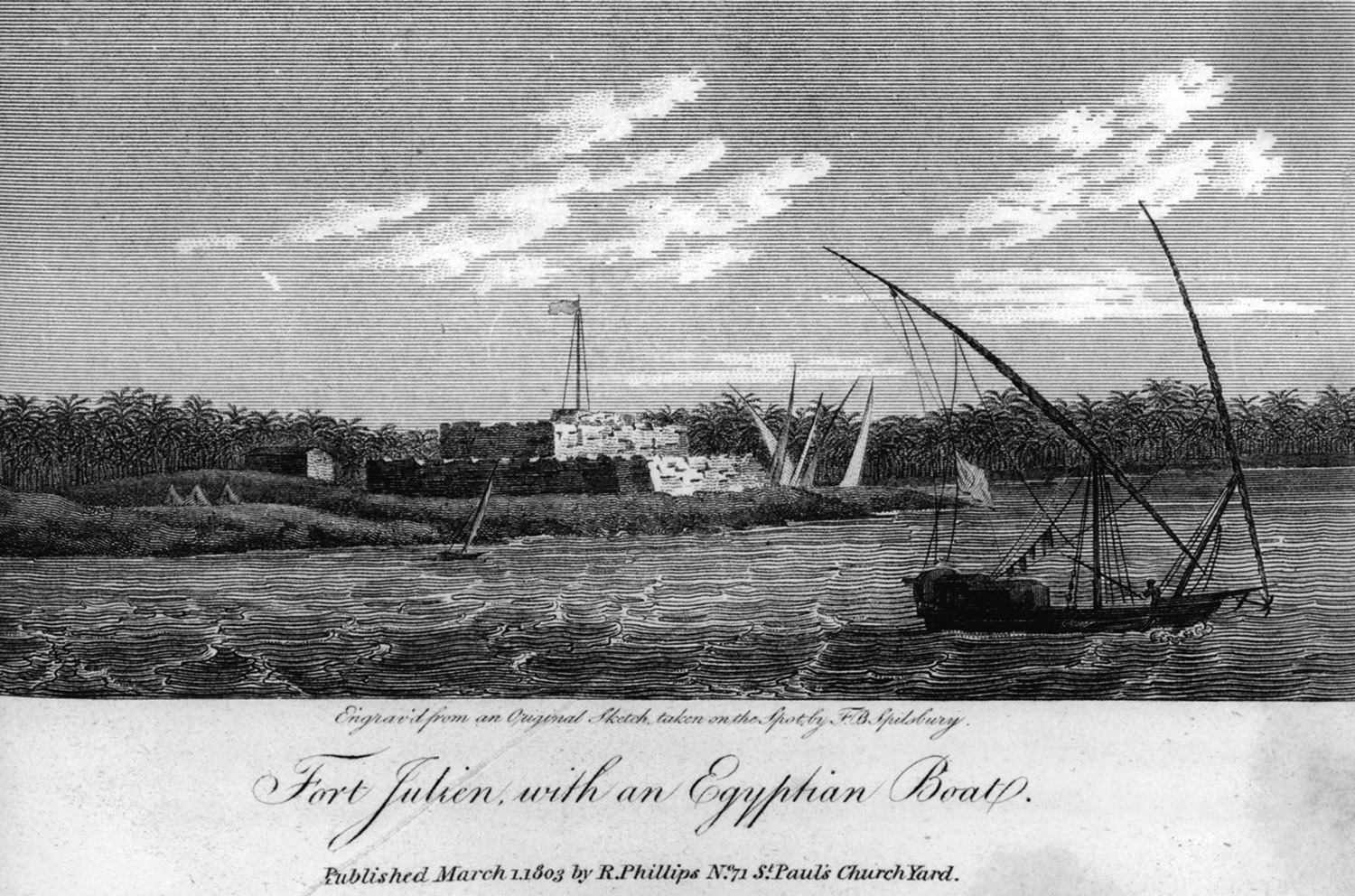Fort Julien on:
[Wikipedia]
[Google]
[Amazon]
 Fort Julien (or, in some sources, ''Fort Rashid'') (
Fort Julien (or, in some sources, ''Fort Rashid'') (
 Fort Julien (or, in some sources, ''Fort Rashid'') (
Fort Julien (or, in some sources, ''Fort Rashid'') (Arabic
Arabic (, , or , ) is a Central Semitic languages, Central Semitic language of the Afroasiatic languages, Afroasiatic language family spoken primarily in the Arab world. The International Organization for Standardization (ISO) assigns lang ...
: طابية رشيد) is a fort
A fortification (also called a fort, fortress, fastness, or stronghold) is a military construction designed for the defense of territories in warfare, and is used to establish rule in a region during peacetime. The term is derived from La ...
located on the left or west bank of the Nile
The Nile (also known as the Nile River or River Nile) is a major north-flowing river in northeastern Africa. It flows into the Mediterranean Sea. The Nile is the longest river in Africa. It has historically been considered the List of river sy ...
about north-west of Rashid ( Rosetta) on the north coast of Egypt
Egypt ( , ), officially the Arab Republic of Egypt, is a country spanning the Northeast Africa, northeast corner of Africa and Western Asia, southwest corner of Asia via the Sinai Peninsula. It is bordered by the Mediterranean Sea to northe ...
. It was originally built by the Mamluks and occupied by the French during Napoleon Bonaparte
Napoleon Bonaparte (born Napoleone di Buonaparte; 15 August 1769 – 5 May 1821), later known by his regnal name Napoleon I, was a French general and statesman who rose to prominence during the French Revolution and led Military career ...
's campaign in Egypt and Syria between 1798 and 1801. The fort became famous as the place where the Rosetta Stone
The Rosetta Stone is a stele of granodiorite inscribed with three versions of a Rosetta Stone decree, decree issued in 196 BC during the Ptolemaic dynasty of ancient Egypt, Egypt, on behalf of King Ptolemy V Epiphanes. The top and middle texts ...
was found in 1799.
Description and history
The fort is a low, squat rectangular structure with a central blockhouse that overlooks the final few kilometres of the Nile before it joins theMediterranean Sea
The Mediterranean Sea ( ) is a sea connected to the Atlantic Ocean, surrounded by the Mediterranean basin and almost completely enclosed by land: on the east by the Levant in West Asia, on the north by Anatolia in West Asia and Southern Eur ...
. It was built around 1470 by the Mamluk
Mamluk or Mamaluk (; (singular), , ''mamālīk'' (plural); translated as "one who is owned", meaning "slave") were non-Arab, ethnically diverse (mostly Turkic, Caucasian, Eastern and Southeastern European) enslaved mercenaries, slave-so ...
Sultan Qait Bey, who also built the eponymous Citadel of Qaitbay in Alexandria
Alexandria ( ; ) is the List of cities and towns in Egypt#Largest cities, second largest city in Egypt and the List of coastal settlements of the Mediterranean Sea, largest city on the Mediterranean coast. It lies at the western edge of the Nile ...
. In 1516, Sultan Qansuh al-Ghuri reinforced it with a defensive wall. The fort subsequently fell into disrepair. The fort was built in part from stone looted from nearby ancient Egyptian sites; when Vivant Denon visited it in 1799, he noted that it was "constructed of parts of old buildings; and that several of the stones of the embrasures were of the fine free-stone of Upper Egypt
Upper Egypt ( ', shortened to , , locally: ) is the southern portion of Egypt and is composed of the Nile River valley south of the delta and the 30th parallel North. It thus consists of the entire Nile River valley from Cairo south to Lake N ...
, and still covered with hieroglyphics."
Discovery of the Rosetta Stone
The French took possession of the dilapidated fort on 19 July 1799, only a few days before the Battle of Abukir, and embarked on a hasty rebuilding. It was subsequently reconstructed in a more thoroughgoing fashion and was renamed Fort Julien afterThomas Prosper Jullien
Thomas Prosper Jullien (21 December 1773, Lapalud - 1798, Egypt) was a French army officer of the French Revolutionary Wars. Aide de camp to Napoleon I of France, Bonaparte, he rose to the rank of captain and was brother of the famous general Louis ...
. One of Napoleon's aides-de-camp, Lieutenant Pierre-François Bouchard, uncovered the famous Rosetta Stone
The Rosetta Stone is a stele of granodiorite inscribed with three versions of a Rosetta Stone decree, decree issued in 196 BC during the Ptolemaic dynasty of ancient Egypt, Egypt, on behalf of King Ptolemy V Epiphanes. The top and middle texts ...
at the fort while repairing its defences. Qait Bey's engineers had apparently brought it to the site from elsewhere, possibly a temple at nearby Sais, to use as fill.Saunders, Nicholas J. ''Alexander's Tomb: The Two Thousand Year Obsession to Find the Lost Conqueror'', p. 134. Basic Books, 2007. Two years later, the fort was captured by a combined British and Turkish force after a short siege and bombardment.
Current condition
The fort was extensively restored by the Egyptian government in the 1980s and reopened in 1985 by PresidentHosni Mubarak
Muhammad Hosni El Sayed Mubarak (; 4 May 1928 – 25 February 2020) was an Egyptian politician and military officer who served as the fourth president of Egypt from 1981 to 2011 and the 41st Prime Minister of Egypt, prime minister from 1981 to ...
. It is now surrounded on three sides by the village of Izbat Burj Rashid and is open to the public. It is possible to reach it by taxi from Rashid.
References
{{Authority control Castles in Egypt Julien History museums in Egypt Mamluk architecture in Egypt Nile Delta Open-air museums in Egypt Ottoman fortifications Buildings and structures in Beheira Governorate Rosetta Stone